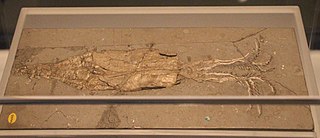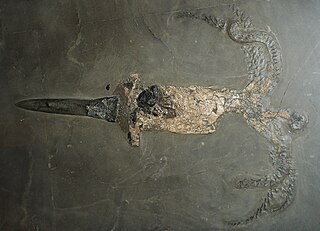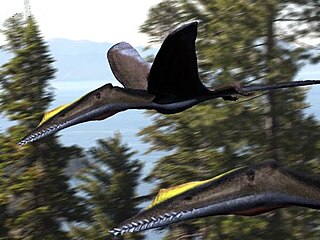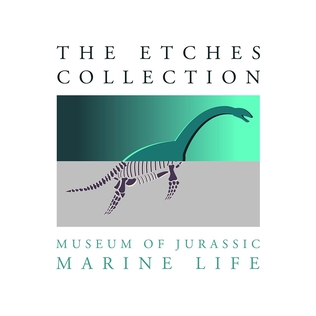
Ammonoids are extinct spiral shelled cephalopods comprising the subclass Ammonoidea. They are more closely related to living coleoids than they are to shelled nautiloids. The earliest ammonoids appeared during the Devonian, with the last species vanishing during or soon after the Cretaceous–Paleogene extinction event. They are often called ammonites, which is most frequently used for members of the order Ammonitida, the only living group of ammonoids from the Jurassic up until their extinction.

Belemnoids are an extinct group of marine cephalopod, very similar in many ways to the modern squid. Like them, the belemnoids possessed an ink sac, but, unlike the squid, they possessed ten arms of roughly equal length, and no tentacles. The name "belemnoid" comes from the Greek word βέλεμνον, belemnon meaning "a dart or arrow" and the Greek word είδος, eidos meaning "form".

Allocrioceras is an ammonoid cephalopod from the Turonian to Santonian stages of the Late Cretaceous, included in the turrilitoid family Anisoceratidae. Its shell is strongly ribbed and is in the form of a widely open spiral.

Aulacostephanus is an extinct ammonoid cephalopod genus from the Upper Jurassic Tithonian belonging to the perisphinctoidean family Aulacostephanidae.

Belemnotheutis is an extinct coleoid cephalopod genus from the middle and upper Jurassic, related to but morphologically distinct from belemnites. Belemnotheutis fossils are some of the best preserved among coleoids. Remains of soft tissue are well-documented in some specimens, even down to microscopic muscle tissue. In 2008, a group of paleontologists even recovered viable ink from ink sacs found in several specimens.

Nannopterygius is an extinct genus of ophthalmosaurid ichthyosaur that lived during the Middle Jurassic to the Early Cretaceous. Fossils are known from England, Kazakhstan, Russia, and Norway and six species are currently assigned to the genus.
The cephalopods have a long geological history, with the first nautiloids found in late Cambrian strata, and purported stem-group representatives present in the earliest Cambrian lagerstätten.

Belemnitida is an extinct order of squid-like cephalopods that existed from the Late Triassic to Late Cretaceous. Unlike squid, belemnites had an internal skeleton that made up the cone. The parts are, from the arms-most to the tip: the tongue-shaped pro-ostracum, the conical phragmocone, and the pointy guard. The calcitic guard is the most common belemnite remain. Belemnites, in life, are thought to have had 10 hooked arms and a pair of fins on the guard. The chitinous hooks were usually no bigger than 5 mm (0.20 in), though a belemnite could have had between 100 and 800 hooks in total, using them to stab and hold onto prey.

Cuspicephalus is an extinct genus of monofenestratan pterosaur known from Dorset in England. Its fossil remains date back to the Late Jurassic period.

Juratyrant is a tyrannosauroid dinosaur genus from the late Jurassic period of England. The genus contains a single species, Juratyrant langhami, which was once classed as a species of Stokesosaurus.

Pectinatites is an extinct cephalopod genus belonging to the order Ammonoidea, that lived during the upper Tithonian stage of the Late Jurassic. They were fast-moving nektonic carnivores.

Egg fossils are the fossilized remains of eggs laid by ancient animals. As evidence of the physiological processes of an animal, egg fossils are considered a type of trace fossil. Under rare circumstances a fossil egg may preserve the remains of the once-developing embryo inside, in which case it also contains body fossils. A wide variety of different animal groups laid eggs that are now preserved in the fossil record beginning in the Paleozoic. Examples include invertebrates like ammonoids as well as vertebrates like fishes, possible amphibians, and reptiles. The latter group includes the many dinosaur eggs that have been recovered from Mesozoic strata. Since the organism responsible for laying any given egg fossil is frequently unknown, scientists classify eggs using a parallel system of taxonomy separate from but modeled after the Linnaean system. This "parataxonomy" is called veterovata.

This timeline of egg fossils research is a chronologically ordered list of important discoveries, controversies of interpretation, taxonomic revisions, and cultural portrayals of egg fossils. Humans have encountered egg fossils for thousands of years. In Stone Age Mongolia, local peoples fashioned fossil dinosaur eggshell into jewelry. In the Americas, fossil eggs may have inspired Navajo creation myths about the human theft of a primordial water monster's egg. Nevertheless, the scientific study of fossil eggs began much later. As reptiles, dinosaurs were presumed to have laid eggs from the 1820s on, when their first scientifically documented remains were being described in England. In 1859, the first scientifically documented dinosaur egg fossils were discovered in southern France by a Catholic priest and amateur naturalist named Father Jean-Jacques Poech, however he thought they were laid by giant birds.

Egg taphonomy is the study of the decomposition and fossilization of eggs. The processes of egg taphonomy begin when the egg either hatches or dies. Eggshell fragments are robust and can often travel great distances before burial. More complete egg specimens gradually begin to fill with sediment, which hardens as minerals precipitate out of water percolating through pores or cracks in the shell. Throughout the fossilization process the calcium carbonate composing the eggshell generally remains unchanged, allowing scientists to study its original structure. However, egg fossils buried under sediments at great depth can be subjected to heat, pressure and chemical processes that can alter the structure of its shell through a process called diagenesis.
Fish egg fossils are the fossilized remains of fish eggs. Fossil fish eggs have an extensive record going at least as far back as the Devonian and spanning into the Cenozoic era. The eggs of many different fish taxa have contributed to this record, including lobe-finned fish, placoderms, and sharks. Occasionally eggs are preserved still within the mother's body, or associated with fossil embryos. Some fossil eggs possibly laid by fish cannot be confidently distinguished from those laid by amphibians; for example, the ichnogenus Mazonova is known from impressions of eggs which resemble eggs of both fish and amphibians. Paleontologist B.K. Hall has observed that the discovery of fossil fish eggs, embryos and larvae link the sciences of paleontology with evo-devo.
Reptile egg fossils are the fossilized remains of eggs laid by reptiles. The fossil record of reptile eggs goes back at least as far as the Early Permian. However, since the earliest reptile eggs probably had soft shells with little preservation potential, reptilian eggs may go back significantly farther than their fossil record. Many ancient reptile groups are known from egg fossils including crocodilians, dinosaurs, and turtles. Some ancient reptiles are known to have given live birth and are therefore not anticipated to have left behind egg fossils.

Cleviceras is an extinct genus of cephalopod belonging to the family Hildoceratidae. These cephalopods existed in the Jurassic period, during Toarcian and possibly even uppermost Pliensbachian age. Sometimes, it is considered to be a synonym of Eleganticeras.

Steve Etches, MBE is an English plumber, fossil collector and preparator in Kimmeridge, on the Isle of Purbeck in Dorset. From an early age on, Etches began to find, collect and restore the fossils he found on the Jurassic Coast. His collection is now housed in a museum called The Etches Collection which was purpose-built, both to house the collection and to replace the deteriorating local village hall. Etches has won many prizes for his palaeontology and was made a Member of the Order of the British Empire by the Queen in 2014. In 2017, he was also awarded an Honorary Doctorate by the University of Southampton. On 22 April 2019, he appeared on the natural history podcast Trees A Crowd with David Oakes.

The Etches Collection is an independent fossil museum located in the village of Kimmeridge, Dorset, England. It is based on the lifetime collection of Steve Etches, a fossil hunter for whom some of his finds have been named, from the local area on the Jurassic Coast, a SSSI and World Heritage Site, especially around Kimmeridge Bay and the Kimmeridge Ledges.

Thalassodraco is an extinct genus of ophthalmosaurid ichthyosaur from the Late Jurassic (Tithonian) Kimmeridge Clay Formation of England. The type species, T. etchesi, was named in 2020, with the epithet in honour of the discoverer of the holotype, Steve Etches.



















